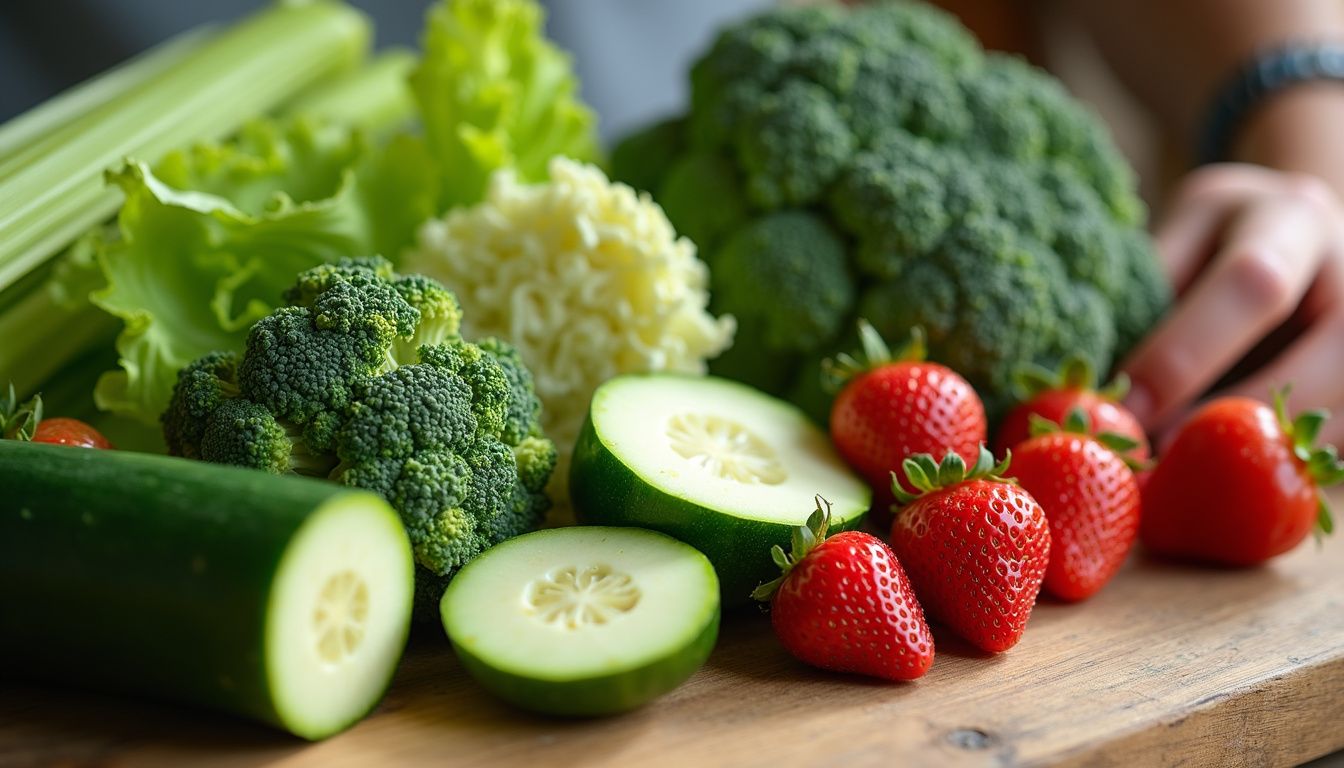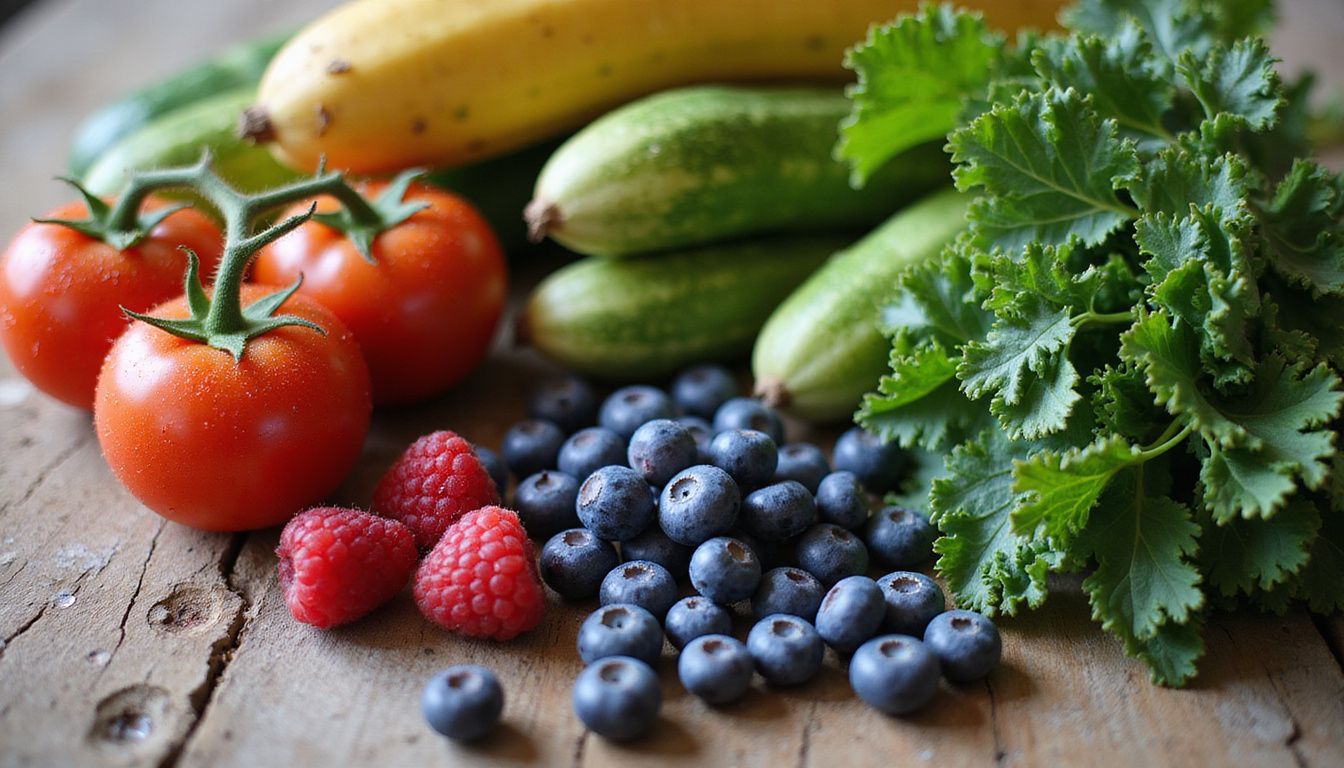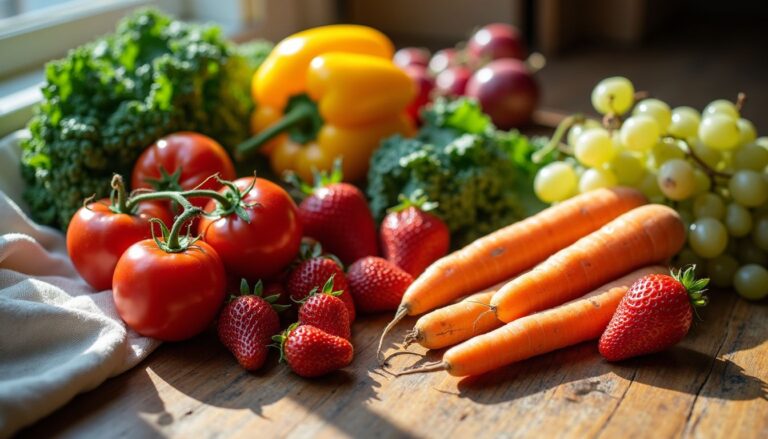Discover The Best Lowest Calorie Foods For Your Low-Calorie Diet
Our Nutrition Assistant AI Suite will transform your body. You will lose fat, get toned, and build muscle. Gain confidence and optimal health.
Many people start a low-calorie diet, then feel tired, hungry, or unsure what to eat. I have been there too. Sorting through choices gets easier once you know which low-calorie foods keep you feeling full.
Picking foods with high water content, like watermelon, helps me eat fewer calories and stay satisfied. In this guide, I share simple ways to choose nutrient-dense foods, the term for foods rich in vitamins and minerals, that fit a low-calorie plan without extra fat. You will find practical tips, quick swaps, and meal ideas that taste good and support a healthy weight.
Key Takeaways
- The FDA calls a food low-calorie if it has 40 calories or less per serving; main dishes must have 120 calories or less per 100 grams.
- Nutrient-dense picks like leafy greens, apples, watermelon, lean meats, Greek yogurt, and whole-grain crackers help you feel full on fewer calories.
- Research in Nutrition Reviews (2022) found high-fiber snacks, such as popcorn or baby carrots, improved fullness more than calorie-dense junk food.
- Swapping higher-calorie foods for strawberries, papaya, and vegetables like spinach supports weight control and heart health.
- Zero-calorie drinks, including water and unsweetened tea, improve diet quality compared with sugary sodas or creamy coffees.

What Are Low-Calorie Foods?

The FDA defines low-calorie foods as items with 40 calories or less per serving. For main dishes, the limit is 120 calories per 100 grams. Foods high in water and fiber often qualify, so you can eat a satisfying portion without a big calorie load.
Great choices include celery, lettuce, cucumber, tomatoes, broccoli, zucchini, and strawberries. These nutrient-rich foods help keep you full because they add volume and fiber. That idea is called low energy density, meaning fewer calories per bite.
Preparation matters. Oil, cheese, or creamy sauces can turn a low-calorie vegetable into a higher-calorie side. I check nutrition data from sources like USDA FoodData Central before I plan meals. Next, I explain how these foods support weight control and better health.
What Are the Benefits of Eating Low-Calorie Foods?
Low-calorie foods help me manage weight while still getting vitamins and minerals. They also support heart health, steady blood sugar, and long-term wellness.
How Do Low-Calorie Foods Help Manage Weight?
Choosing foods that are low in calories makes weight management simpler. I swap calorie-dense snacks, like donuts or fries, for high-volume foods such as apples or sautéed vegetables. That change reduces my daily calorie intake without shrinking my plate.
One small order of fries, about 250 calories, equals the calories in ten cups of spinach plus one and a half cups of strawberries and one small apple. I can eat more food, feel satisfied, and still take in fewer calories per bite.
Fruits and vegetables have low energy density because they contain lots of water and dietary fiber but little fat or sugar. That mix helps me feel full longer. Studies show higher intakes of these foods support weight-loss plans and better health outcomes.
Dried fruit is different. One cup of raisins has about 480 calories, while a cup of grapes has about 104. I choose fresh fruit more often to keep calories in check.
These swaps cut excess fat and added sugar from my day. I also get more hydration, vitamin C, beta-carotene, and potassium. Next, I cover how these foods help control hunger between meals.
How Do Low-Calorie Foods Increase Satiety?
Low-calorie foods like grapefruit and carrots are high in water, which boosts volume without many calories. Grapefruit is about 90 percent water and has 64 calories per half. A medium carrot is 88 percent water with just 25 calories.
Fiber adds staying power. Air-popped popcorn slows digestion and expands in the gut. One cup has around 30 calories but feels filling because of its bulk.
Salad greens, tomatoes, broccoli, asparagus, and zucchini are low in fat and high in volume. Eating more of these water-rich, high-fiber vegetables supports the Academy of Nutrition and Dietetics guidance for healthy eating. This approach can help you stick with calorie restriction for weight loss or health goals.
Which Essential Nutrients Do Low-Calorie Foods Provide?
Low-calorie choices can still deliver key nutrients. Leafy greens and fruits are great examples. A cup of cooked kale offers over 100 percent of the Daily Value for vitamins C and K. A cup of apple slices brings fiber and vitamin C with few calories.
Watermelon provides vitamin C while staying under 50 calories per cup. Cruciferous vegetables, such as broccoli and Brussels sprouts, supply vitamin C and plant compounds called phytochemicals that support health.
Leafy greens like spinach contain lutein and zeaxanthin, two antioxidants that help protect eye health. Choosing a range of foods, from whole grains to lean proteins, increases potassium, calcium, folate, and fiber without a lot of fat.
Which Low-Calorie Fruits Should I Include in My Diet?
Lower-calorie fruits fit well into a healthy diet, add sweetness, and keep calories in check, all while supplying vitamins and fiber.
Apples
One cup of sliced apples, about 109 grams, has only 62 calories. That makes apples a smart pick for weight management. Each serving offers almost 3 grams of fiber to support digestion and fullness.
I pack apple slices for snacks or add them to salads for crunch. Their natural sweetness helps me skip candy and cookies. Apples fit well into plans focused on weight loss and heart health.
Clementines
Clementines taste bright and keep calories low. One medium fruit, about 74 grams, has just 35 calories and supplies about 40 percent of the Daily Value for vitamin C. Vitamin C supports immune function and helps your body absorb iron from foods like leafy greens.
I toss clementines into my lunch bag or stir the segments into plain Greek yogurt. They have little sodium and no saturated fat, which supports heart-healthy eating.
Strawberries
Strawberries are light and filling. One cup of sliced berries, 166 grams, has only 53 calories and plenty of fiber. They add volume without many calories and fit well in smoothies, yogurt bowls, or oatmeal.
I also like the research linking strawberries to brain health. They bring color, flavor, and vitamin C with very few calories.
Watermelon
Watermelon is refreshing and low in calories. One cup, 154 grams, has only 46 calories and is rich in vitamin C. I snack on chilled slices in summer to stay hydrated without adding much to my daily calorie total.
Watermelon contains lycopene, a plant pigment that may support heart health. Its natural sweetness makes it easy to choose fruit over high-calorie desserts.
Papaya
Papaya tastes sweet and fits a low-calorie plan. A small papaya, 157 grams, has about 68 calories. It provides vitamin C, provitamin A, folate, and potassium.
I add papaya cubes to cereal or blend them with plain low-fat Greek yogurt for extra protein and calcium. Its fiber helps me feel full, and the high water content is hydrating. Papaya pairs well with other low-calorie fruits like strawberries or clementines.
What Are the Best Low-Calorie Vegetables for Meals?
Vegetables bring color, crunch, and nutrients to meals while keeping calories low. Mix and match for variety through the week.
Leafy Greens: Kale, Spinach, Chard
Kale, spinach, and chard deliver a lot of nutrition for very few calories. One cup of raw spinach or chard has only 7 calories and is an excellent source of vitamin K and provitamin A. A cooked cup of kale has about 49 calories and provides over 100 percent of the Daily Value for vitamins C and K.
I stir chopped kale into soup, layer spinach in sandwiches, and sauté chard with a small amount of olive oil. The fiber in these greens helps me stay full longer.
Root Vegetables: Radishes, Turnips, Beets
Root vegetables add crunch and color with modest calories. A cup of radishes, 116 grams, has 19 calories plus vitamin C, potassium, and folate. A cooked cup of turnips, 156 grams, has 34 calories and a good amount of vitamin C.
Beets bring natural sweetness and nutrients. One cooked cup, 170 grams, has 74 calories along with folate, manganese, and plant compounds that support health. I roast them for salads or grain bowls.
Cruciferous Vegetables: Broccoli, Cabbage, Cauliflower, Brussels Sprouts
Cruciferous vegetables are hearty and low in calories. A cooked cup of broccoli, 155 grams, has about 54 calories and more than 100 percent of the Daily Value for vitamin C. Studies associate higher intake with better heart health.
Brussels sprouts have about 70 calories per cooked cup and are rich in vitamin C. Cabbage offers only 22 calories per raw cup and works well in slaws. Cauliflower is popular as a rice swap. One cooked cup has about 40 calories with far fewer carbs than regular rice.
I use these vegetables in stir-fries, soups, and even as pizza crusts. They keep meals filling without many calories.
Water-Rich Vegetables: Celery, Cucumbers, Iceberg Lettuce
Water-rich vegetables help me manage hunger with almost no calories. A cup of celery, 120 grams, has about 17 calories. Half a cup of cucumbers, 52 grams, has just 8 calories. I use cucumber slices as dippers with cottage cheese or hummus.
Iceberg lettuce also earns a spot. A cup, 57 grams, has only 8 calories and supplies vitamin K and provitamin A. Swapping bread for lettuce wraps can cut calories while keeping meals crunchy and fresh.
What Are Good Low-Calorie Protein Sources?
Protein helps you feel full and supports muscles. I choose options that are rich in protein and lower in calories to fit a calorie-restricted plan.
Eggs
Egg whites are one of the lowest-calorie protein sources. One large egg white has about 17 calories and nearly 4 grams of high-quality protein. Whole eggs bring more calories, but they are nutrient-rich and pair well with low-calorie vegetables.
I hard-boil eggs for quick breakfasts. They keep me full longer and add vitamin D, choline, selenium, and B vitamins. If I want fewer calories, I use more egg whites and fewer yolks.
Low-Fat Cottage Cheese
Low-fat cottage cheese gives me protein with fewer calories than many dairy products. A half-cup serving has about 80 calories. I mix it with strawberries or apple slices for a snack, or I spoon it over a baked potato instead of a heavy sauce.
The high-quality protein supports muscle maintenance during weight loss. It is an easy way to add variety without pushing calories up.
Plain Low-Fat Greek Yogurt
Plain low-fat Greek yogurt has about 73 calories per 100 grams and is high in protein. I use it in place of cream in dips or desserts. Lemon juice, chopped nuts, or seeds add flavor without many calories.
This yogurt supplies calcium and feels creamy. I like it with fresh fruit, such as strawberries or papaya, for a snack that satisfies without excess sugar.
Lean Meats: Chicken, Turkey, Fish
Lean meats deliver protein with modest calories. Skinless chicken breast, turkey breast, and white fish are reliable choices. For example, turkey breast has about 147 calories per 100 grams. Cod has around 84 calories per 100 grams, and tilapia fillets are close to 100 calories for the same weight. A five-ounce can of tuna is roughly 110 calories.
I bake or grill these proteins with garlic, herbs, or a teaspoon of olive oil. They taste great with vegetables and fit well in a low-calorie eating plan.
What Are Healthy Low-Calorie Snack Options?
I look for snacks that combine fiber and protein. This pairing improves fullness, helps with weight goals, and keeps energy steady.
Air-Popped Popcorn
Air-popped popcorn is light and filling. One cup has about 30 calories and a good amount of fiber for the volume. The crunch helps me skip cookies and chips.
I choose unflavored popcorn to avoid extra sodium and sugar. High-fiber snacks are linked to better appetite control and fewer urges to graze.
Baby Carrots with Hummus
Carrots are an excellent source of fiber and water, yet they are low in calories. One cup of baby carrots has about 50 calories. A tablespoon of hummus adds about 25 calories, plus protein and healthy fat from chickpeas and tahini.
I keep a container of baby carrots and hummus ready for quick snacking. Research suggests snacks with both fiber and protein increase fullness more than high-calorie treats.[1]
Apple Slices with Peanut Butter
Apple slices with peanut butter make a quick, satisfying snack. One medium apple has about 95 calories and provides fiber and vitamin C. One tablespoon of peanut butter adds healthy fats and protein, bringing the total to roughly 180 calories.
The mix of fiber and fat helps steady blood sugar and curb cravings. It feels like dessert, without the sugar crash.
Blueberry Smoothie
Blueberries are low in calories and high in antioxidants. A half-cup has about 32 calories. I blend blueberries with low-fat Greek yogurt or milk for protein and calcium. Ripe berries add natural sweetness, so I skip added sugar.
A simple smoothie with one cup of blueberries and half a cup of low-fat milk is usually about 130 to 150 calories. It is a refreshing snack that fills me up between meals.
Frozen Banana Pops
I slice ripe bananas, freeze the pieces on small skewers, and dip them in a thin layer of dark chocolate. A medium banana has about 105 calories, but a small pop uses around a third of that. Dark chocolate adds flavor and antioxidants with fewer added sugars than milk chocolate.
These pops satisfy a sweet tooth and help me skip candy. They also provide fiber and potassium from the banana.
What Are Low-Calorie Carbohydrate Alternatives?
Low-calorie carb swaps help me keep portions generous while trimming energy intake. They also pair well with lean protein and vegetables.
Zucchini Noodles
Zucchini noodles are a handy pasta alternative. One cup of raw zucchini has about 20 calories. They fill my plate without adding many carbs.
I like them with tomato sauce and grilled chicken or edamame. Zucchini provides fiber and vitamin C, which support fullness and immune health.^[1] I use them in cold salads or hot stir-fries.
…
^[1]: USDA FoodData Central: Zucchini Nutrition Facts (2024).
Cauliflower Rice
Cauliflower rice is a low-calorie, low-carb swap for white rice. One cooked cup has about 40 calories and around 8 grams of carbs. I pulse florets in a food processor until they resemble small grains, then sauté them quickly.
Cauliflower adds fiber and vitamins with fewer calories, so I use it in stir-fries and curries. The texture and taste work well in most rice dishes.
Whole-Grain Crackers
Whole-grain crackers made with oats, bran, or whole wheat add fiber and minerals. A serving brings moderate calories plus B vitamins, iron, and magnesium. For crunch, I pair a small serving with low-fat cheese or orange slices.
This swap keeps hunger in check and makes it easier to stick to a low-calorie plan.
How Can I Create Balanced, Low-Calorie Meals?
I build meals around lean protein, plenty of vegetables, smart fats, and bold seasoning. That mix keeps flavor high and calories reasonable.
Combining Lean Protein with Vegetables
Pairing lean protein with vegetables boosts fullness and nutrient density. For example, a cup of cooked broccoli, about 54 calories, plus a portion of chicken breast creates a meal that is satisfying and light.
I often combine spinach or cauliflower with grilled turkey or white fish. Larger portions of vegetables help me meet my calorie target without feeling deprived.
Adding Healthy Fats in Moderation
I add small amounts of healthy fats, like avocado slices, nuts, or seeds. These fats help me feel satisfied and improve absorption of vitamins A, D, E, and K.
One ounce of almonds has about 160 calories and provides vitamin E and magnesium. A few avocado slices bring flavor and texture without excess oil. Research from Harvard T.H. Chan School of Public Health suggests replacing saturated fat with unsaturated fat supports heart health.
Using Herbs and Spices for Flavor Without Calories
Herbs and spices lift flavor with almost no calories. I season with basil, cilantro, garlic powder, cumin, or black pepper in place of heavy sauces and dressings.
Fresh parsley adds antioxidants for less than 5 calories per tablespoon. I often toss leafy greens with lemon juice and dill for a zesty salad. This simple shift keeps meals light and tasty.
What Beverages Are Best for a Low-Calorie Diet?
Drinks can add many hidden calories. I choose options that hydrate and keep calories low.
Water
Water has zero calories and keeps me hydrated all day. Reaching for water instead of sugary drinks helps me avoid extra snacking and makes a low-calorie plan easier to follow.
Water-rich foods, such as watermelon, add hydration too. A 154-gram serving has just 46 calories. Plain water and hydrating foods help me skip soda and sweet coffee drinks.
Unsweetened Tea
Unsweetened tea has little to no calories. Black or green tea, without sugar, supplies antioxidants and fits a calorie-controlled diet.
I drink hot tea in the morning and iced tea in warm weather. It keeps me hydrated and adds variety without raising my daily calories.
Black Coffee
Black coffee offers about 2 calories per 8-ounce cup and a gentle caffeine lift. Studies suggest regular coffee drinkers may have a lower risk of some chronic diseases.
I avoid adding sugar or cream since those extras can raise calories fast. Plain coffee pairs well with a light snack.
Infused Water with Lemon or Cucumber
I add lemon or cucumber slices to water for flavor without sugar. Infused water is crisp and helps me drink more through the day.
Half a cup of cucumber has just 8 calories. Drinking more water can support weight management because it helps me feel fuller and less likely to sip high-calorie beverages.
Which Foods Should I Limit on a Low-Calorie Diet?
Some foods pack many calories into small portions. I limit these to stay on track and protect my progress.
Avoiding Sugary Snacks
Donuts, candies, and sweet pastries are high in calories and low in nutrients. A glazed donut can top 250 calories. A candy bar often sits near 200 calories or more.
Instead, I choose air-popped popcorn or fruit. I find it easier to manage cravings and energy when I skip sugar-heavy snacks.
Steering Clear of High-Calorie Processed Foods
Ultra-processed foods often hide extra calories and added sugars. Studies link high intake to weight gain and worse health outcomes. Many packaged chips, frozen dinners, and sweetened cereals fall into this group.
These foods also drive cravings for more. Replacing them with whole foods, such as zucchini noodles or cauliflower rice, helps me cut calories and feel satisfied.
Excluding Calorie-Dense Fried Foods
Fried foods absorb oil and raise calories quickly. A medium fast-food order of fries can have more than 300 calories and about 17 grams of fat.
I choose grilled or baked options instead of fried. That single change made a clear difference in my weight management and energy.
Conclusion
Finding the best lowest calorie foods turns a low-calorie diet into a plan you can live with. I focus on nutrient-dense fruits and vegetables, lean protein, whole grains, and smart snacks that keep me full on fewer calories. I limit sugary snacks, ultra-processed items, and fried foods to avoid hidden calories.
Small swaps add up. Pick one change this week, like replacing fries with air-popped popcorn or using cauliflower rice at dinner. If you have a medical condition, or you take medications, talk with your clinician or a registered dietitian for personal guidance. Healthy habits grow one meal at a time.
[1] Satiety effects of dietary fiber: a systematic review and meta-analysis,
Nutrition Reviews, May 2022
FAQs
1. What are the best lowest calorie foods for a low-calorie diet?
Leafy greens, cucumbers, tomatoes, and mushrooms rank among the top choices for low-calorie diets. These vegetables contain high water content and provide essential vitamins with very few calories per serving. For example, spinach has about 7 calories per cup while cucumbers have only 8 calories per half-cup slice according to USDA data.
2. How can I use these foods in my daily meals?
You can add leafy greens to salads or wraps, include sliced tomatoes in sandwiches, and stir-fry mushrooms as a side dish. Using these ingredients helps you feel full without adding many calories to your meal plan.
3. Are there any fruits that fit into a low-calorie eating pattern?
Yes; strawberries, watermelon slices, and grapefruit segments are excellent fruit options for those seeking lower calorie intake. One cup of strawberries contains about 50 calories while one cup of diced watermelon provides roughly 46 calories based on nutritional databases.
4. Can eating more lowest calorie foods help with weight management?
Research shows that choosing foods with fewer calories but higher fiber like leafy vegetables or certain fruits supports satiety and may aid weight control efforts (Rolls et al., American Journal of Clinical Nutrition). Including these items regularly makes it easier to maintain a balanced diet over time.
Summary: Selecting nutrient-rich yet lowest calorie produce such as leafy greens or berries allows you to enjoy larger portions while keeping total energy intake modest; this approach is supported by scientific evidence for effective dietary planning.







